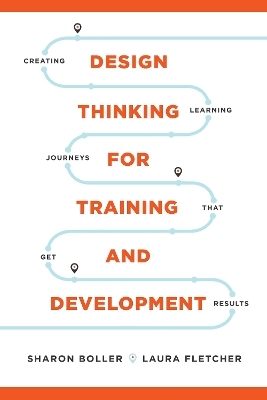
Design Thinking for Training and Development
ATD Press (Verlag)
978-1-950496-18-1 (ISBN)
Better Learning Solutions Through Better Learning Experiences
When training and development initiatives treat learning as something that occurs as a one-time event, the learner and the business suffer. Using design thinking can help talent development professionals ensure learning sticks to drive improved performance.
Design Thinking for Training and Development offers a primer on design thinking, a human-centered process and problem-solving methodology that focuses on involving users of a solution in its design. For effective design thinking, talent development professionals need to go beyond the UX, the user experience, and incorporate the LX, the learner experience.
In this how-to guide for applying design thinking tools and techniques, Sharon Boller and Laura Fletcher share how they adapted the traditional design thinking process for training and development projects. Their process involves steps to:
Get perspective.
Refine the problem.
Ideate and prototype.
Iterate (develop, test, pilot, and refine).
Implement.
Design thinking is about balancing the three forces on training and development programs: learner wants and needs, business needs, and constraints. Learn how to get buy-in from skeptical stakeholders. Discover why taking requests for training, gathering the perspective of stakeholders and learners, and crafting problem statements will uncover the true issue at hand.
Two in-depth case studies show how the authors made design thinking work. Job aids and tools featured in this book include:
a strategy blueprint to uncover what a stakeholder is trying to solve
an empathy map to capture the learner’s thoughts, actions, motivators, and challenges
an experience map to better understand how the learner performs.
With its hands-on, use-it-today approach, this book will get you started on your own journey to applying design thinking.
Sharon Boller is a managing director at TiER1 Performance where she focuses on helping clients figure out how to activate their business strategies through their people. She partners with her colleagues at Tier1 to bring together the disciplines of learning, change, communication, technology, and creativity to create blended solutions that enable people to do their best work. Prior to joining TiER1 Performance, Sharon was the CEO and president of Bottom-Line Performance (BLP), a learning solutions firm she founded in 1995. She and her partner/co-owner Kirk Boller grew BLP from a single-woman sole proprietorship to a $4 million-plus company with a highly skilled team of diverse capabilities. Under the direction of Sharon and Kirk, BLP produced communication, education, and training solutions for life science companies, manufacturing, energy companies, and more. Sharon is a frequent speaker at industry conferences on topics such as performance-focused learning design, UX, technology and trends, learning game design, and design thinking. She is the author of two other books published by ATD Press: Teamwork Training was published in 1995, and Play to Learn: Everything You Need to Know About Designing Effective Learning Games was published in 2017 with co-author Karl Kapp. Her company is the recipient of more than 30 awards from organizations such as Brandon Hall, Horizon Interactive Awards, and Life Science Trainers and Educators Network. Her industry interests are wide-ranging and include storytelling, emerging technologies, business strategy, leadership, learning, and experience design. Laura Fletcher is a seasoned learning consultant with 15 years’ experience in learning and development. She served the clients of Bottom-Line Performance for over seven years, where she designed and developed award-winning solutions ranging from instructor-led workshops to mobile apps. It was during her tenure as manager of Instructional Design at Bottom-Line Performance that her ID team became something of a design-thinking “incubation lab,” experimenting with design thinking techniques and integrating them into the design process. Today she works for a global technology company where she applies the same principles of design thinking to develop future leaders in the tech industry. She has a master’s degree in Human Resource Development from the University of Illinois, and lives in Indianapolis with her husband and two children. Laura Fletcher is a seasoned learning consultant with 15 years’ experience in learning and development. She served the clients of Bottom-Line Performance for over seven years, where she designed and developed award-winning solutions ranging from instructor-led workshops to mobile apps. It was during her tenure as manager of Instructional Design at Bottom-Line Performance that her ID team became something of a design-thinking “incubation lab,” experimenting with design thinking techniques and integrating them into the design process. Today she works for a global technology company where she applies the same principles of design thinking to develop future leaders in the tech industry. She has a master’s degree in Human Resource Development from the University of Illinois, and lives in Indianapolis with her husband and two children.
Introduction
Section 1: Get Acquainted With Design Thinking
1: A Primer on Design Thinking
2: Linking Design Thinking to Learning Experiences
3: A Framework for Integrating Design Thinking Into Training and Development
Section 2: Get Perspective and Refine the Problem
4: Start With the Business Perspective
5: Pull in the Learner
6: Verify Constraints as You Go
Section 3: Ideate, Prototype, and Iterate
7: Ideate and Prototype
8: Refine and Develop
Section 4: Implement
9: Implement
10: Evaluate
Section 5: Sell Your Use Case
11: Get Buy-In From Stakeholders
12: Using Design Thinking When a Project Is Underway
13: NxStage Case Study
14: CAISO Case Study
| Erscheinungsdatum | 02.07.2020 |
|---|---|
| Reihe/Serie | None |
| Zusatzinfo | Illustrations |
| Verlagsort | Alexandria |
| Sprache | englisch |
| Maße | 152 x 228 mm |
| Themenwelt | Wirtschaft ► Betriebswirtschaft / Management ► Personalwesen |
| Wirtschaft ► Betriebswirtschaft / Management ► Projektmanagement | |
| ISBN-10 | 1-950496-18-X / 195049618X |
| ISBN-13 | 978-1-950496-18-1 / 9781950496181 |
| Zustand | Neuware |
| Haben Sie eine Frage zum Produkt? |
aus dem Bereich


